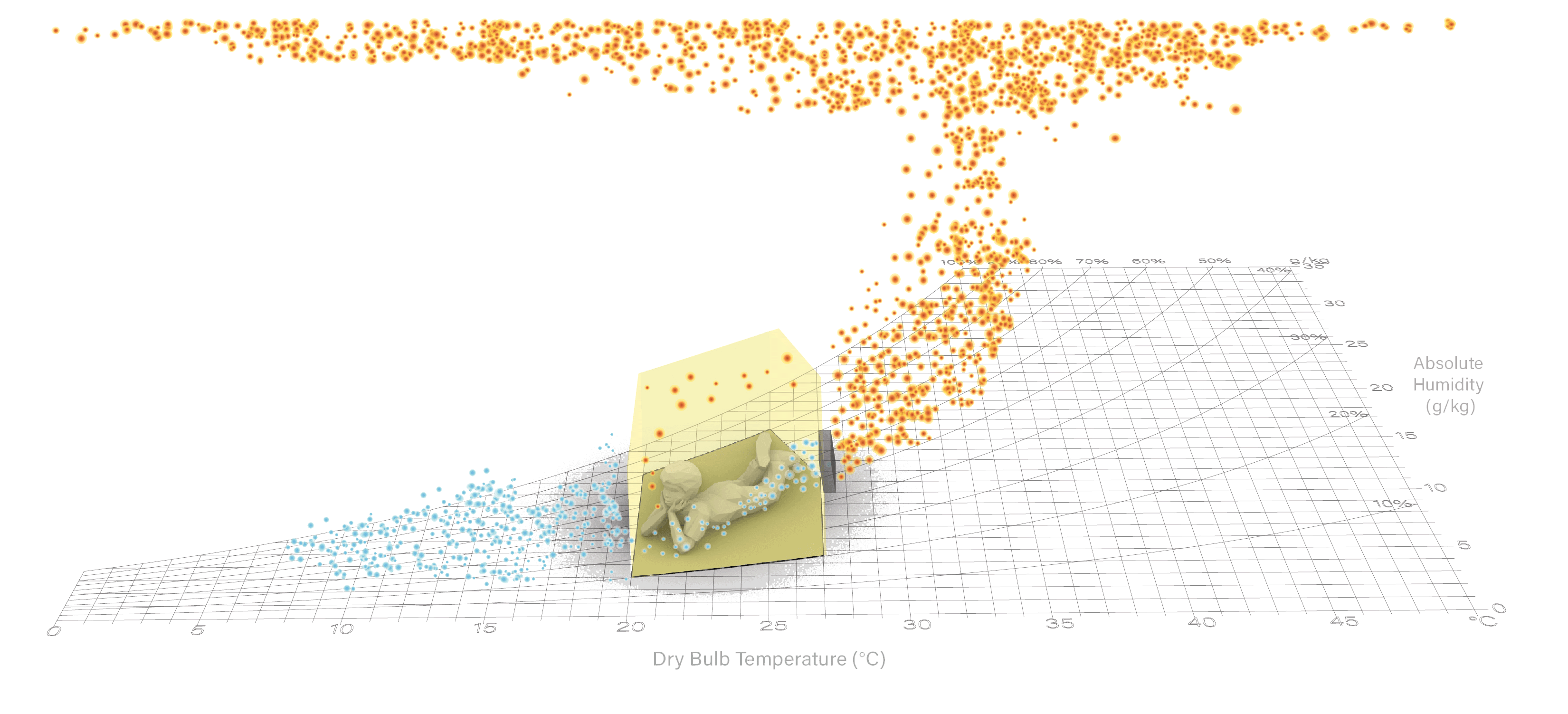The human domestication projects involves the selection of variety of species or traits that fundamentally alter a species to become more useful or friendly to the human species. Lorenzo Del Savio and Matteo Mameli, “Human domestication and the roles of human agency in human evolution,” History and Philosophy of the Life Sciences 42, no. 2 (2020): 1.
United Nations Environment Programme and the International Energy Agency, Cooling Emissions and Policy Synthesis Report: Benefits of cooling efficiency and the Kigali Amendment (Nairobi; Paris: UNEP and IEA, 2020), 4.
The “great indoors” describes the dynamics of indoor ecologies that are markedly distinct from the outdoors—from unique indoor surface chemistry patterns to changing multispecies inhabitation patterns. Dawn Day Biehler and Gregory L. Simon, “The great indoors: Research frontiers on indoor environments as active political-ecological spaces,” Progress in Human Geography 35, no. 2 (2011): 182–186. Matthew A. Bertone, Misha Leong, Keith M. Bayless, Tara LF Malow, Robert R. Dunn, and Michelle D. Trautwein, “Arthropods of the great indoors: characterizing diversity inside urban and suburban homes,” PeerJ 4 (2016): 1582.
Lucile H. Brockway, “Science and colonial expansion: the role of the British Royal Botanic Gardens,” American Ethnologist 6, no. 3 (1979): 449–455. Zaheer Baber, “The plants of empire: botanic gardens, colonial power and botanical knowledge,” Journal of Contemporary Asia 46, no. 4 (2016): 659–679.
Brockway, “Science and colonial expansion,” 450–452.
Douglas Chambers, “John Evelyn and the invention of the heated greenhouse,” Garden History 20, no. 2 (1992): 202–205.
Edward Diestelkamp, “Richard Turner and the Palm House at Kew Gardens,” Transactions of the Newcomen Society 54, no. 1 (1982): 3–4.
Edward Diestelkamp, “Horticulture under glass,” Occasional Papers from The RHS Lindley Library 17 (2019): 16–22.
Michael D. Purugganan, “Evolutionary insights into the nature of plant domestication,” Current Biology 29, no. 14 (2019): R708–709.
Dorinda Outram, “New spaces in natural history.” In: Nicholas Jardine, James A. Secord, and E. C. Spary eds., Cultures of Natural History (Cambridge; New York: Cambridge University Press, 1996), 249.
Henrik Schoenefeldt, “The Crystal Palace, Environmentally Considered,” Architectural Research Quarterly 12, no. 3-4 (2008): 289.
Ibid, 291.
John W. Stamper, “London’s Crystal Palace and Its Decorative Iron Construction.” In: Function and Fantasy: Iron Architecture in the Long Nineteenth Century (Routledge: 2016), 27–28.
Henrik Schoenefeldt, “Adapting glasshouses for human use: environmental experimentation in Paxton’s designs for the 1851 great exhibition building and the Crystal Palace, Sydenham,” Architectural History 54 (2011): 252–259.
Bill Luckin, “‘The heart and home of horror’: The great London fogs of the late nineteenth century,” Social History 28, no. 1 (2003): 35. Schoenefeldt, “Adapting glasshouses for human use,” 246.
Patrick Bowe, “Lal Bagh—The Botanical Garden of Bangalore and Its Kew-Trained Gardeners,” Garden History (2012): 232–233.
Franklin Ginn, “Colonial transformations: Nature, progress and science in the Christchurch Botanic Gardens,” New Zealand Geographer 65, no. 1 (2009): 37.
Bernard Nagengast, “100 years of air conditioning,” ASHRAE Journal 44, no. 6 (2002): 44–46.
Gail Cooper, Air-Conditioning America: Engineers and the Controlled Environment, 1900-1960 (Baltimore: Johns Hopkins University Press, 2002), 68.
Jiat-Hwee Chang, “Thermal comfort and climatic design in the tropics: an historical critique,” The Journal of Architecture 21, no. 8 (2016): 1178.
Cooper, Air-Conditioning America, 73-74.
Michelle Murphy, Sick Building Syndrome and the Problem Of Uncertainty (Durham: Duke University Press, 2006), 25.
Chang, “Thermal comfort and climatic design in the tropics”: 1181.
Richard De Dear and Gail Schiller Brager, “Developing an adaptive model of thermal comfort and preference,” ASHRAE Transactions 104 (1998): 145–167. Richard De Dear and Gail Schiller Brager. “The adaptive model of thermal comfort and energy conservation in the built environment,” International Journal of Biometeorology 45, no. 2 (2001): 100–108.
Chang, “Thermal comfort and climatic design in the tropics”: 1172.
Ibid.
Ola Uduku, “Modernist architecture and ‘the tropical’ in West Africa: The tropical architecture movement in West Africa, 1948–1970,” Habitat International 30, no. 3 (2006): 404.
Tim Winter, “An uncomfortable truth: air-conditioning and sustainability in Asia,” Environment and Planning A 45, no. 3 (2013): 525.
Priya Jain, “Clean, Cool Air: Health and Air-Conditioning in India (1920s–1960s),” Journal of Architectural Education 76, no. 1 (2022): 133–135.
Lee Kuan Yew, “The East Asian Way—With Air Conditioning,” New Perspectives Quarterly 26, no. 4 (2009): 120.
Chang, “Thermal comfort and climatic design in the tropics”: 1182.
